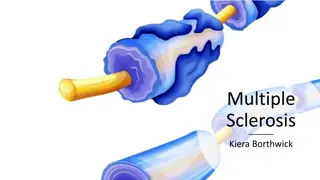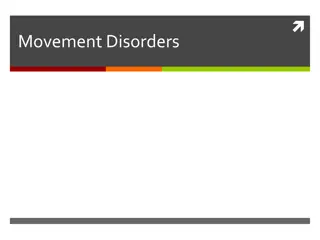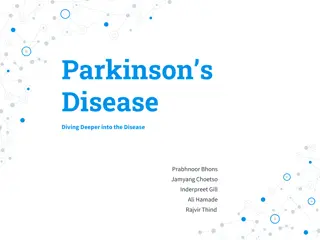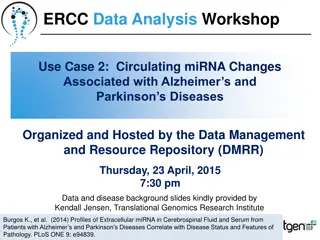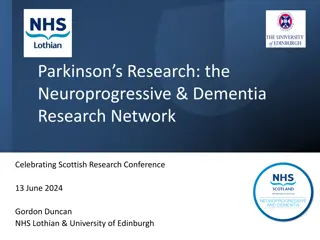
Parkinson's Disease: Symptoms, Causes, and Treatment
Understanding Parkinson's disease, its symptoms, causes, and treatment options is crucial for managing the condition and supporting those affected.
Uploaded on | 0 Views
Download Presentation

Please find below an Image/Link to download the presentation.
The content on the website is provided AS IS for your information and personal use only. It may not be sold, licensed, or shared on other websites without obtaining consent from the author. If you encounter any issues during the download, it is possible that the publisher has removed the file from their server.
You are allowed to download the files provided on this website for personal or commercial use, subject to the condition that they are used lawfully. All files are the property of their respective owners.
The content on the website is provided AS IS for your information and personal use only. It may not be sold, licensed, or shared on other websites without obtaining consent from the author.
E N D
Presentation Transcript
Parkinsons Disease: Symptoms, Causes, and Treatment Parkinson s disease is a progressive neurological disorder that affects movement and can significantly impact a person s quality of life. It primarily affects the motor system and is characterized by a range of symptoms that worsen over time. Understanding Parkinson s disease, its symptoms, causes, and treatment options is crucial for managing the condition and supporting those affected. What is Parkinson s Disease? Parkinson s disease is a chronic and progressive disorder of the nervous system that predominantly affects dopamine-producing neurons in a specific area of the brain called the substantia nigra. Dopamine is a neurotransmitter that plays a vital role in sending messages to the part of the brain that controls movement and coordination. As dopamine levels decrease, it becomes increasingly difficult for the brain to regulate movement and coordination. Common Symptoms The symptoms of this disease typically develop gradually and can vary greatly from one person to another. They are generally divided into motor and non-motor symptoms. Motor Symptoms Tremors Tremors or shaking, often starting in the hand or fingers, are one of the most recognizable signs. This often occurs at rest and may decrease when performing actions.
Bradykinesia Bradykinesia refers to the slowness of movement, making simple tasks time-consuming and difficult. Muscle Rigidity Stiffness in the muscles can occur, often starting in the limbs or neck, and can lead to pain and a reduced range of motion. Postural Instability Balance and coordination problems can lead to a stooped posture and an increased risk of falls. Gait Changes Individuals may develop a shuffling walk, with short steps and reduced arm swing. Non-Motor Symptoms Cognitive Impairment Cognitive changes, including memory problems and difficulty concentrating, can occur. Mood Disorders Depression, anxiety, and apathy are common among those with Parkinson s disease.
Sleep Disorders Problems such as insomnia, REM sleep behavior disorder, and restless legs syndrome can affect sleep quality. Autonomic Dysfunction Issues such as constipation, urinary problems, and orthostatic hypotension (a drop in blood pressure when standing up) can occur due to the dysfunction of the autonomic nervous system. Sensory Changes Changes in the sense of smell, as well as pain and discomfort, can also be symptoms. Causes and Risk Factors The exact cause of Parkinson s disease is unknown, but it is believed to result from a combination of genetic and environmental factors. Genetic Factors Although most cases of Parkinson s are sporadic, a small percentage of cases are hereditary. Mutations in specific genes such as LRRK2, PARK7, and SNCA have been linked to the disease. Environmental Factors Exposure to certain toxins, such as pesticides and heavy metals, may increase the risk of developing Parkinson s disease. Age The risk of this disease increases with age, with most people developing the condition after the age of 60. Gender Men are more likely to develop Parkinson s disease than women. Head Injury
A history of head injuries may increase the risk of developing this disease. Diagnosing There is no specific test for Parkinson s disease. Diagnosis is based on medical history, a review of signs and symptoms, and a neurological examination. Doctors may also use imaging tests, such as MRI or PET scans, to rule out other conditions. Neurological Examination A neurologist will assess motor symptoms such as tremors, rigidity, and bradykinesia, as well as non- motor symptoms. Response to Medication A positive response to Parkinson s medication, such as levodopa, can support the diagnosis. Treatment Options While there is no cure for Parkinson s disease, several treatments can help manage symptoms and improve quality of life. Medications Levodopa/Carbidopa: The most effective medication for Parkinson s, it helps replenish dopamine levels. Dopamine Agonists: Medications that mimic dopamine effects in the brain, such as pramipexole and ropinirole. MAO-B Inhibitors: These medications, such as selegiline and rasagiline, help prevent the breakdown of brain dopamine.
COMT Inhibitors: Entacapone and tolcapone prolong the effect of levodopa by blocking an enzyme that breaks down dopamine. Anticholinergics: These can help control tremors. Amantadine: Provides short-term relief of symptoms in early-stage Parkinson s. Surgical Treatment Deep Brain Stimulation (DBS): A surgical procedure where electrodes are implanted in specific areas of the brain to deliver electrical impulses that help regulate abnormal brain activity. Lifestyle and Supportive Therapies Physical Therapy: Focuses on improving mobility, balance, and flexibility. Occupational Therapy: Helps with daily activities and maintaining independence. Speech Therapy: Addresses speech and swallowing difficulties. Exercise: Regular physical activity can improve muscle strength, flexibility, and overall well-being. Diet and Nutrition: A balanced diet can help manage symptoms and support overall health. Living with Parkinson s Disease Managing Parkinson s disease involves a comprehensive approach that includes medical treatment, lifestyle adjustments, and support from healthcare professionals, family, and friends. Stay Active Regular exercise can help maintain mobility and improve mood. Stay Informed Keep up-to-date with the latest research and treatment options. Build a Support Network
Connect with support groups, family, and friends who can offer emotional and practical support. Adapt Your Environment Make home modifications to enhance safety and ease of movement. Plan Ahead Anticipate future needs and make arrangements for long-term care if necessary. Conclusion Parkinson s disease is a complex and progressive neurological disorder that requires a multifaceted approach to management. While there is currently no cure, understanding the symptoms, causes, and treatment options can significantly improve the quality of life for those affected. Early diagnosis, appropriate medical treatment, and lifestyle adjustments can help manage symptoms and maintain independence. If you or a loved one is experiencing symptoms of Parkinson s disease, consult a healthcare provider for a comprehensive evaluation and personalized treatment plan. References By staying informed and proactive, individuals with Parkinson s disease can manage their symptoms effectively and lead fulfilling lives. Working closely with healthcare providers and building a strong support network are essential steps in navigating the challenges posed by this condition. Parkinson s Foundation Mayo Clinic National Institute of Neurological Disorders and Stroke (NINDS) Find practical solutions to common challenges through our insightful articles on Healthcare 360 Magazine


